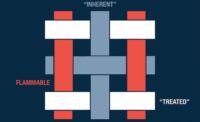What do “inherent” and “treated” really mean?

Inherent” and “treated” are arguably the most overused and misleading terms in the FR world. These terms were imported into the FR world more than 40 years ago, and accurately reflected the FR durability of technology at the time. However, like most technologies, enormous advances have been made in the decades since then; the first “treated” product that was FR for the life of the garment was introduced in 1987.
Thus the terms “inherent” and “treated,” as commonly understood, ceased to be a relevant differentiator among FR fabrics more than 25 years ago. As such, there are at least four notable problems with these labels:
- They were not originally textile science terms.
- The definitions have changed over time.
- They have been inconsistently and inaccurately used.
- The labels refer to single fiber types, but fabrics are most often blends of multiple fiber types.
Sales literature and marketing spin, coupled with repetition over time, have created impressions in the marketplace that simply are not borne by facts. Durability of FR properties has been proven over time, both by independent labs and in real life, with tens of millions of garments in service worldwide over decades.
“Inherent” and “treated” have ceased to be relevant differentiators; the technology has long since outstripped the terminology.
Definitions
The definition of “inherent” varies slightly from source to source, but the common thrust is “by its very nature, a core property” while “treated” is defined as chemical engineering to impart FR properties not previously present.
However, you may be surprised to learn that all flame resistant fibers in common use today for industrial protective apparel are engineered by humans, using chemistry, to be flame resistant. The “inherent” fibers tend to be synthetics and begin as naturally occurring flammable substances (petrochemicals), not fibers. Humans must intervene using chemistry to engineer the fiber and the FR properties.
Similarly, most “treated” products begin as naturally occurring flammable substances (usually cotton or other cellulosics), so nature has already taken care of the fiber portion and humans must get involved to engineer the FR.
Safety professionals agree it’s not the process that’s important, it’s the final fabric properties and the durability of those properties to laundering and the environment.
Shifting definitions over time
Significant product characterization issues have recently emerged as well. Some technologies that were clearly characterized by the market for decades as “treated” have suddenly been recast as “inherent.” The definitions shifted to suit the interest of the defining party. One example involves fibers whose process involves adding flame retardant chemicals during spinning, which was originally defined as “treated.” Yet in the last several years, a number of catalogs have relabeled fabrics containing these fibers as “inherent.”
Blends
Most popular FR fabrics today are blends of different fibers, and this has created another level of misuse and misunderstanding. In addition to the issues around definitions and individual fiber technologies, what blend level should be necessary to call a fabric “inherent?”
Should we call a blend of inherent and treated fibers inherent, and if so, at what ratio of “inherent” to “treated?”
There are many examples of blended fabrics currently being marketed as “inherent” that contain less than 50 percent “inherent” fibers—and some contain as little as 15 percent.
In fact, some “inherent” fabrics even contain non-FR fibers. There are even fabrics that contain up to 80 percent flammable fibers being marketed as “inherent.”
Conclusion
The fabric properties most important to wearers of flame resistant apparel are protection, comfort and value. Durability of these properties is critical; what ultimately matters most is that the apparel is FR for the life of the garment, and market-proven. The terms “inherent” and “treated” may have been relevant 30-plus years ago when there were only a few commercially available FR fabrics and the “treated” options did in fact eventually wash out.
But FR technology, like cellphones, has come a very long way in three decades, rendering these categorizations outmoded, inaccurate and/or actively misleading, both on the fiber level and as applied to fabric blends. “Inherent” and “treated” have ceased to be relevant differentiators; the technology has long since outstripped the terminology. They have become marketing terms, undefined and unenforced by standards bodies, and subject to situational redefinition on both a fiber and fabric level.
Ultimately, FR clothing decisions should not be based on the terms “inherent” and “treated,” but on fabrics that are guaranteed FR for the life of the garment.
Looking for a reprint of this article?
From high-res PDFs to custom plaques, order your copy today!




